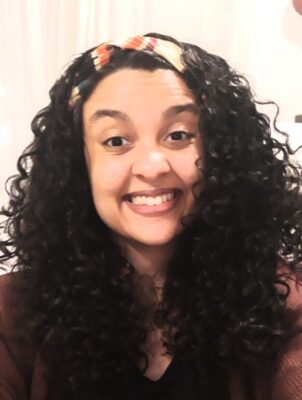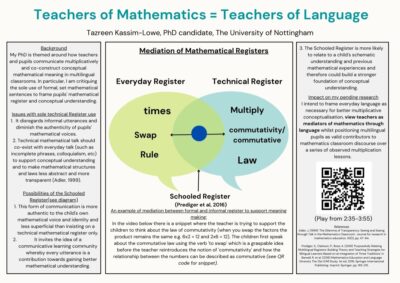Tazreen Kassim-Lowe about language learning in the Maths class
 Tazreen is a former primary school teacher and Maths lead who has also received EAL coordinator training with the Bell Foundation. She is a tutor and an accredited Professional Development lead for the National Centre in the Excellence of Teaching Mathematics. She is currently studying for her doctorate at the University of Nottingham
Tazreen is a former primary school teacher and Maths lead who has also received EAL coordinator training with the Bell Foundation. She is a tutor and an accredited Professional Development lead for the National Centre in the Excellence of Teaching Mathematics. She is currently studying for her doctorate at the University of Nottingham
Research context
My research is themed around Teacher mediation of Mathematical discourse whilst teaching Multiplicative concepts in Multilingual classrooms. The aim of this study is to make sense of ‘language structures’, which are formal, set, ‘fill in the gap’ sentences, in the context of teaching multiplication in a multilingual primary classroom.
The term ‘language structures’ were first described in the Department for Education (DfE) non-statutory guidance in KS1 and KS2 Mathematics (2020). However, according to Coles and Helme (2022, p.16), language structures are not a research-driven practice even though the DfE non-Statutory guidance claims that language structures develop, ‘….precise and accurate language in mathematics …to capture, connect and apply important mathematical ideas’. (DfE, 2020, p.6)
I intend to consider how being a ‘professional sceptic’ and contemplating a research outlook that is questioning, cautious and critical may be appropriate when considering the complex role of language and conceptual understanding of multiplication within classroom discourse. I will be adopting a critical discourse analysis approach and in particular, Anna Sfard’s (2008) Communicational theory which considers classroom discourse as multimodal including a) words; b) endorsed narratives, c) visual mediators and d) routines. I am most interested in how teachers mediate mathematical discourse as well as value and build on multilingual pupils’ contributions to the conceptual co-construction of multiplication. In the following poster, I illustrate how mathematical registers can be mediated.

Click here to see the full poster
I am at the start of my doctoral journey. From analysing the literature, a variety of both technical/formal and everyday/informal language is necessary to grapple with new mathematical concepts (Prediger et al, 2016). It is therefore the role of the teacher as a mediator to decide how to use the grammatical formality of language structures, technical mathematical language, and the informal utterance of pupils’ everyday language to build a better conceptual understanding and disambiguate multiplication for the whole class (Adler, 1999).
References
Adler, J. (1999) ‘The Dilemma of Transparency: Seeing and Seeing through Talk in the Mathematics Classroom’, Journal for research in mathematics education, 30(1), pp. 47–64.
Coles, A and Helme, R. (2022) Teaching for mastery in primary mathematics: A study of translating research into policy and practice, Review of Education, 10, e3326.
Department for Education (2020) Non-Statutory Maths Guidance: KS1 and KS2
Prediger et al. (2016) ‘Purposefully Relating Multilingual Registers: Building Theory and Teaching Strategies for Bilingual Learners Based on an Integration of Three Traditions’ in Barwell et al. (ed.) Mathematics Education and Language Diversity The 21st ICMI Study. 1st ed. Springer International Publishing, pp. 193-215.
Sfard, A. (2008). Thinking as Communicating: Human Development, the Growth of Discourses, and Mathematizing (Learning in Doing: Social, Cognitive and Computational Perspectives). Cambridge: Cambridge University Press.

